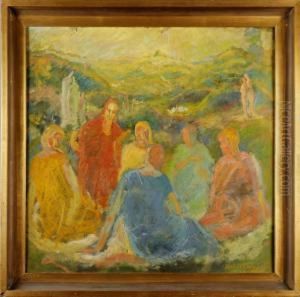Alphons Schnegg Paintings
Alphons Schnegg was an Austrian sculptor active in the late 19th and early 20th centuries. Born in 1865, Schnegg's artistic career was shaped by the vibrant cultural and artistic milieu of Austria-Hungary, a period marked by significant artistic innovation and experimentation. His work is often associated with the broader movements of Art Nouveau and Symbolism, which sought to break away from the traditional forms and subjects of the past to embrace more organic, flowing designs and deeper symbolic content.
Schnegg received his formal education at the Academy of Fine Arts Vienna, where he was exposed to a wide range of artistic influences and techniques. This education provided him with a solid foundation in the traditional principles of sculpture, which he would later expand upon in his own unique direction. Throughout his career, Schnegg was known for his mastery in handling materials, particularly marble and bronze, which he often used to create figures and forms that combined naturalistic detail with a more stylized, abstract quality.
His work during this period reflects a fascination with the human form, as well as with themes of nature, mythology, and allegory. Schnegg's sculptures often evoke a sense of movement and fluidity, characteristics that align with the Art Nouveau movement's emphasis on dynamic and organic forms. Despite the stylistic affiliations with Art Nouveau and Symbolism, Schnegg maintained a distinct personal style characterized by a delicate balance between realism and idealization.
Not just limited to free-standing sculptures, Schnegg also engaged in decorative arts and monument design, contributing to the architectural beautification and cultural heritage of Austria. His works were well received in his time, earning him commissions and recognition among his contemporaries. However, like many artists of his era, his name has not remained as prominent in the broader art historical narrative as some of his peers.
Alphons Schnegg's contributions to the field of sculpture and decorative arts remain an important part of the artistic legacy of Austria-Hungary's turn of the century. He passed away in 1933, leaving behind a body of work that continues to be appreciated by art historians and collectors for its craftsmanship and unique aesthetic qualities. Schnegg's art captures the spirit of an era that was on the cusp of modernity, reflecting the tensions and innovations of his time through the timeless medium of sculpture.
